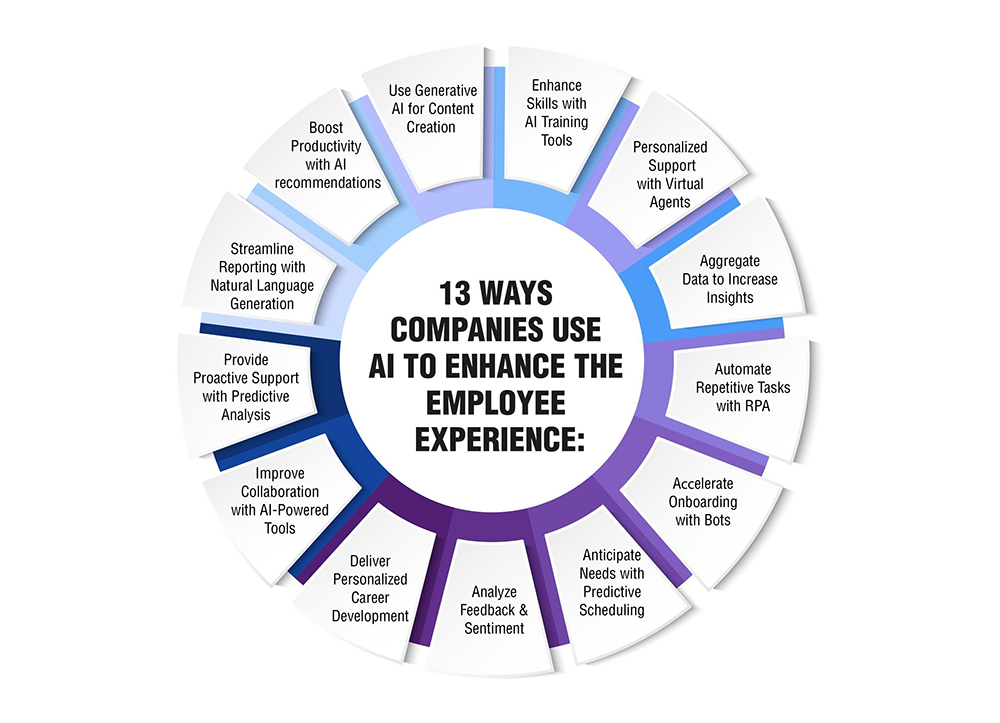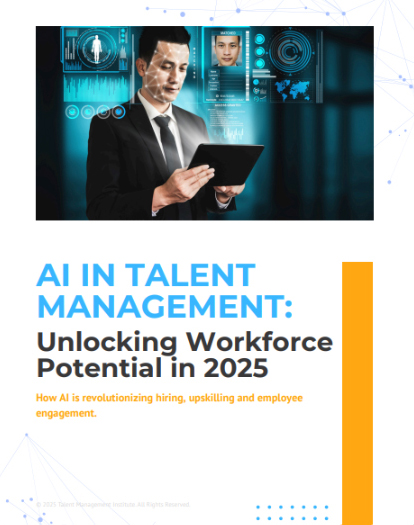
The key to running a successful business is creating an environment that fosters an exceptional employee experience (EX). Happy employees are more productive, provide better customer service, and increase customer satisfaction (CSAT) - all of which positively improve the bottom line. However, outdated systems, siloed data, and repetitive tasks can diminish the employee experience and lead to burnout.
Artificial intelligence (AI) offers a solution. When integrated strategically, AI in HR can modernize the employee journey by simplifying workflows, personalizing support, and optimizing team performance. This article explores several ways companies are leveraging AI to enhance the employee experience.
Why Leverage AI to Enhance Employee Experience?
There is a clear need for companies to enhance employee experience by incorporating AI technology
-
With AI tools, companies can create a more efficient work environment that boosts employee satisfaction and reduces burnout. This leads to higher employee retention rates and engaged staff who are brand advocates.
-
When employees struggle to find relevant information or are bogged down with repetitive tasks, it negatively impacts their work. AI solutions like chatbots and virtual assistants can help by providing answers to questions through natural language conversations.
-
Collecting regular feedback is important for companies to understand how they can enhance the employee experience. AI makes it possible to analyze large amounts of survey responses, messages, and other data to gain valuable insights into what is working well and areas that need improvement. Issues can be addressed before they escalate.
-
Data from different systems is often siloed, making it hard for teams to collaborate effectively to assist internal customers. AI can consolidate this information to break down barriers and provide a unified view of the employee experience. When departments function as one coordinated team, employees receive faster and more consistent support.
-
Predictive analytics using AI can also help companies provide proactive assistance to employees. For example, signs of burnout can be identified early and resolved with targeted interventions.
-
Creating and updating content like training materials, policies, and reports is a time-intensive process for companies. AI tools based on natural language generation automate most of this work. Details can be personalized while general language is structured consistently.
In summary, leveraging AI enhances the employee experience in many ways that benefit both the company and its staff. Tasks are simplified, and employees feel less stressed and supported in their work. Companies see outcomes like higher satisfaction, lower turnover, and more productive teams when AI is used strategically to power the tools and systems that power the employee experience.
How Companies are Integrating AI to Enhance the Employee Experience
Here are some ways companies are using AI to enhance the employee experience:

-
Enhance Agents' Skills with AI Training Tools
Remember the simulation programs in The Matrix that instantly uploaded fighting skills to Neo's mind? AI-powered training tools function similarly, supercharging employees' abilities. Chatbots and virtual agents deliver instant answers by searching internal knowledge bases. Generative AI even responds to unique questions by analyzing past answers.
Tools like Anthropic's Constitutional AI teach models appropriate workplace conduct instead of promoting harmful biases. Strategic implementation of ethics-focused AI ensures skills development benefits all.
-
Provide Personalized Support with Virtual Agents
Unlike general chatbots, advanced conversational AI agents understand context and personalize interactions. Natural language processing allows searching across siloed systems, while adaptive learning improves over time.
Virtual agents address employees by name and role, understand intent, and escalate unresolved issues appropriately. Personalization increases satisfaction - people prefer interactions mirroring human conversation. Intuitive design streamlines accessing documents, policies, paystubs, and more.
-
Highlighting Employer Value Proposition (EVP)
Articulate unique workplace culture, growth opportunities, benefits, and perks to showcase why your hotel presents an attractive career option.
-
Aggregate Data to Increase Insights
AI assists in making sense of dispersed data in HR, IT, facilities, and other systems. By connecting information, businesses gain a holistic view of employee journeys. Teams analyze metrics like time-to-hire, turnover rates, training feedback, and more to pinpoint pain points.
Predictive analytics also identify at-risk individuals proactively. For example, an uptick in late arrivals or longer-than-usual lunch breaks could signal issues AI alerts managers to address compassionately. Data-driven insights optimize processes and support individual needs.
-
Automate Repetitive Tasks with RPA
Robotic process automation (RPA) handles high-volume, predictable activities through software "robots" that mimic human actions. This frees employees from strategic, customer-focused responsibilities. Common automated tasks include:
-
Onboarding paperwork like new hire paperwork, payroll setup, and ID badges
-
Reconciliation like expense reports, time-off balances, and inventory
-
Data entry from applications into various systems
By removing mundane, non-strategic activities, RPA boosts productivity and job satisfaction. It also improves data quality by eliminating human error from repetitive duties.
-
Accelerate Onboarding with Bots
Onboarding sets the tone for an employee's entire experience. AI-powered chatbots streamline the process, providing 24/7 access to essential information. Bots greet new hires, describe benefits, assist with IT setup, and more.
Conversational interfaces tailor the information based on an individual's role and department. Self-service checklists allow tracking progress independently. Automating routine tasks gives managers more time for meaningful interactions that boost culture fit and retention.
-
Anticipate Needs with Predictive Scheduling
AI aggregates historical data to auto-generate optimal staff schedules based on factors like seasonality, past attendance, skills, and preferences. Algorithms consider variables like minimizing overtime costs while ensuring adequate coverage.
Predictive scheduling improves work-life balance by accommodating life events. It also reduces costs from over- or under-staffing particular shifts. Auto-scheduling streamlines coordination between managers and employees.
-
Analyze Feedback and Sentiment
Pulsing short surveys after training, meetings, or other points provides valuable qualitative feedback. AI discerns sentiment and identifies common themes through natural language processing (NLP). It also tracks metrics to gauge program efficiency over time.
Managers gain real-time insights to refine experiences, like adjusting onboarding curriculum based on trainee confusion or frustration. Businesses build community and boost morale by celebrating small wins or kudos mentioned in open-ended comments. Sentiment analysis strengthens EX continually.
-
Deliver Personalized Career Development
AI assesses profiles, performance reviews, competencies, and interests to recommend personalized growth opportunities like coaching, certifications or stretch assignments. Managers gain objective data supporting career conversations.
Employees access self-service guidance and gain autonomy in defining their paths. Customized development motivates high performers and retains top talent by addressing their unique career ambitions. AI ensures nobody gets overlooked for opportunities that match their strengths.
-
Improve Collaboration with AI-Powered Tools
Linking communication platforms streamlines teamwork. For example, many AI roles integrate with Slack, so questions sent via chatbot trigger ticket creation and assignment. Tracking these interactions provides usage metrics to enhance agent experiences over time.
Other collaborative AI tools include virtual scribes that transcribe and action-item meetings. Managers can request attendance forecasts, reference past notes, or generate agendas and reminders. Centralizing data empowers dispersed teams through universal access to expertise and resources. Employees access self-service guidance and gain autonomy in defining their paths. Customized development motivates high performers and retains top talent by addressing their unique career ambitions. AI ensures nobody gets overlooked for opportunities that match their strengths.
-
Provide Proactive Support with Predictive Analysis
Similar to how AI detects customer abandonment on websites, it recognizes indicators of employee burnout, like changed communication patterns or production declines. Intelligent assistance then addresses root causes to improve well-being and retention.
For example, a bot might privately message an agent taking longer breaks to suggest an Ergonomic assessment, note local counseling options, or remind about work-life balance initiatives. By intercepting issues early, predictive support curbs resignations that damage EX.
-
Streamline Reporting with Natural Language Generation
Drafting routine reports consumes significant time. NLG automates documentation using conversational questions to extract key details from subject matter experts. AI then composes structured, readable reports in a fraction of the time.
Teams accelerate tasks like auditing expenses, updating policies, and conveying program results up the chain. Compliance improves as automated writing eliminates human errors or omissions. Leaders gain timely insights for strategic decisions that uplift all employees.
-
Boost Productivity with AI recommendations
Automated assistant tools like Anthropic Assistant provide guidance optimized for each employee's role. AI recommends focus areas to maximize efficiency based on analyses of top performers. Suggestions could include minimizing interruptions, batching related tasks, or focusing in periods of peak clarity.
Personalized nudges motivate professionals intrinsically by emphasizing areas for mastery over routines. Productivity soars when habits align natural talents to strategic goals. AI ensures distributed workers stay energized, engaged, and important regardless of location.
-
Leverage Generative AI for Content Creation
Automated writing tools rapidly generate everything from new-hire packets to training modules using simple templates. Department leaders provide topic overviews, then review polished drafts requiring minimal editing.
Content generators also summarize documents, weave quotes into narratives, and produce reports from structured data. By condensing information into more consumable formats, AI strengthens knowledge sharing and continuous learning, which are vital for innovative cultures. Output still reflects the organization's brand voice.
Conclusion
Employee experience is the foundation for success in today's talent-driven economy. Strategic AI integration modernizes processes to optimize support, development, and production for all individuals. Data-driven personalization elevates engagement and satisfaction while freeing personnel for strategic responsibilities. Overall, AI enhances experiences that retain top performers and fuel business growth. The opportunities for enhancing EX (Employee experience) using new technologies are only just beginning.




